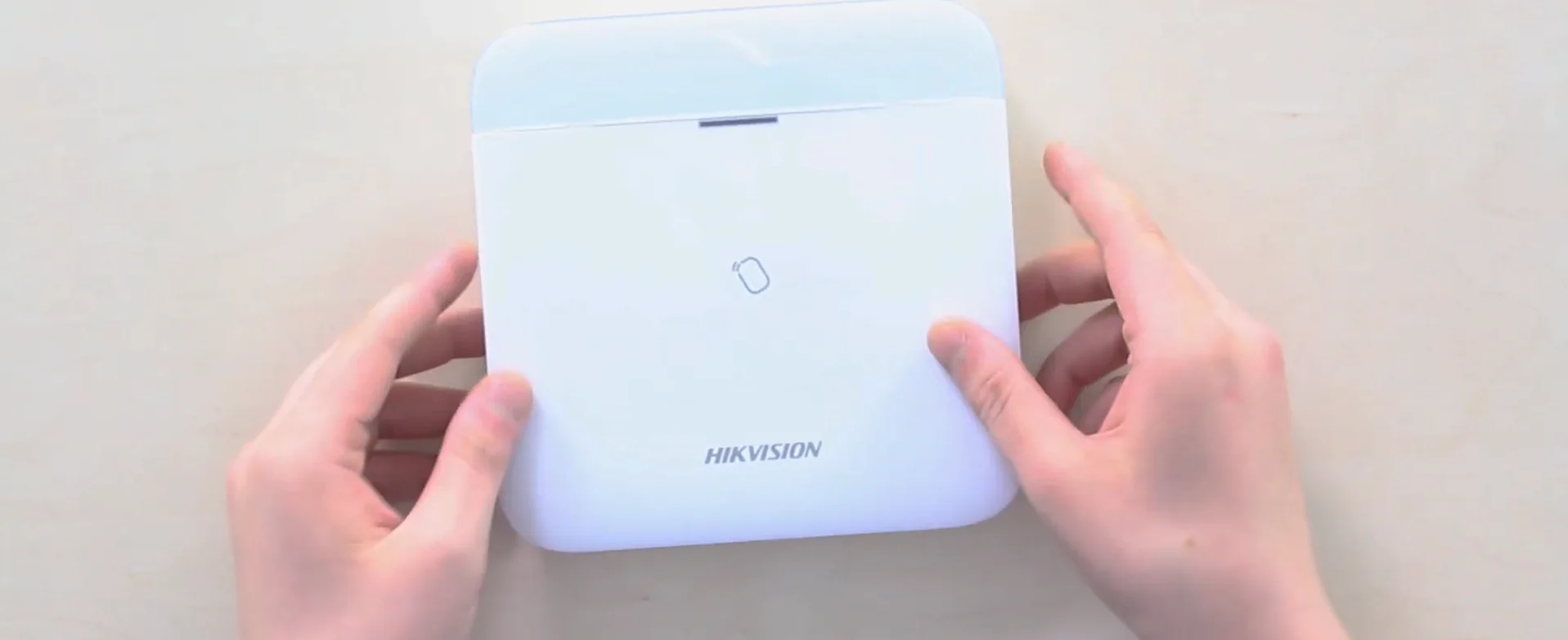-
- Definition / Intent / Radio Protocols / Distance / Protection & Encryption;
- The Hardware;
- Communication: Wi-fi / wired LAN / 2 SIM-cards 3G & 4G;
- Devices / Peripherals / Numbers;
- Other Features / Nice Extras: Tag Reader, Cellular Voice Call, Cellular SMS, Voice Prompt;
- Plug & Play Activation / Set Up: Hik-Connect, Hik-ProConnect, IVMS-4200, Hik-central;
- Network Cameras: Hikvision and 3rd-party.
Hikvision AX Pro Hub Main Unit – I’m sure you want to get to know it better before purchasing, and fortunately, there are things to tell about it, a lot of things to be exact. Hikvision AX PRO Hub Review on the Pipl Systems Store, my name’s Daniel.
Features Overview
AX Pro Hub. A lot of things to cover according to the graphics above, but first things first. What is this AX Pro Hub? What transmission technology is used and what are its features? The AX Pro Hub takes central place in the system – it manages and maintains the 2-side communication between you and all sensors, detectors, and peripherals that you throw into the system.
The communication itself is performed over the radio waves on 868 MHz. Frequency, common for modern wireless alarm systems. Hikvision is proud of what they achieved here – they call it TRI-X and CAM-X. Those are the chips that execute the data transmission processes, where TRI-X maintains the common signals delivery: open / closed / tamper/threat and others for as far as 2,000 m.
And the CAM-X is responsible for photo transmission from a PIRCAM device, which reaches 800 m. maximum, which is justified by the fact that photos are way heavier files, and this range is optimal to get you both speed and reach. Here’s a little demo:
The data protection is provided due to the AES-128 protocol encryption. The system features anti-jamming scenarios, and regarding the transmission clarity and interferences, Hikvision implemented techniques such as frequency hopping, allowing the system to automatically adjust frequencies for data transmission among 50 different channels to avoid interferences.
Body Overview
The Design – Hikvision AX Pro Hub looks like how you would expect the alarm system’s central unit to look. White square-form neutral box, made from thick glossy plastic on top and sides, which is pretty scratchable, but the build feels solid overall. The front panel is divided into 2 parts, where a top grey line contains system status indicators: malfunctions, ethernet status, armed or disarmed state, and the alarm. The LED below is a power indicator, and here’s the first difference of the hubs – the advanced M-version has a tag-reader built in it, which is indicated with the card icon, while the L-version Hub is just empty there.
Within the box, you have RFID tags – they are simply put over the reader → you get sound notification → and with this action, you can disarm the system, clear alarm messages, and et cetera. On the back, the lid is both a mounting bracket and the lid protective internal functional elements. There’s a tamper switch reset button, serial ports 1 and 2, power in, Ethernet wire in, power switch, and 2 SIM-card slots.
Communications
The communication subject. We went through that. The AX Hub has 2 chips built in it for data transmission over radio frequencies, but concerning the communication with the user, in total with AX Pro, you get 4 communication channels between you and the Hub. Common wired internet connection, Wi-fi, and 2x SIM-cards, both supporting 4G and 3G networks. Plus, the AX Hub can call you over the cellular network and even send you an SMS if there’s no other way to reach you. Although what I just said is related to AX Hub M version only, because the younger “L” version has a single SIM-card slot, supporting GPRS 2G networks only.
The System’s Scale
The number of devices that you can connect to a single Hub of the L version at once is 142 devices. For the larger “M-version” Hub, it is 210. That includes: 96 wireless input appliances – detectors, sensors, buttons, and wireless output devices: relays and wall switches. Then, you can get here 6 wireless indoor and outdoor sounders, or sirens, 4 wireless repeaters, or signal range extenders, 8 keypads, and tag readers. And finally, 48 key fobs and 48 RFID tags for 48 users, including 1 admin and 1 installer. In total, 210 devices to connect to a single AX Pro Hub at once, which can be controlled by 48 users.
Other Important Features
Other features that should be mentioned. Voice prompt on the AX Pro Hub – it reports every status change by means of audio: system armed, disarmed, alarm event occurred, and many other minor ones, which is just comfortable, to also get an audio confirmation. The next awesome feature is that the Hub is able to send you a message and even call you over the cellular network, if there are no other ways to reach you at the moment. Next up is the characteristic called the “Onboard IP Camera Integration” – that means that there is a local storage in the AX Pro Hub M, which is used to save 4 video clips with event recordings, each up to 7s in length, from the connected IP cameras. Minor one, yes, but still, more security is always better.
Activation and System Use
This is a plug & play appliance, and therefore, you start working with it right out of the box. To do that, supply your Hub with power and internet over the wires from the box, but don’t close the lid. Switch the toggle to the on position, and while it boots up, install a free Hik-connect phone app. Wait till you see the indication and Hub prompts that it’s ready to work. And then from a Hik-connect phone app, press the “plus” button, scan the QR code, go back to the rear part of the Hub and scan its QR code, name it inside the app, and it’s ready to work. You can see its status, configure it the way you want, and start adding sensors.
Network Cameras Integration
Certainly, a crucial feature is the network cameras integration. And yes, it was expected from Hikvision, a video surveillance appliance manufacturer, but surprisingly, they didn’t limit you to just Hikvision cameras. No, they allow you to get any 3rd-party cameras due to the ONVIF protocol. And basically, that means that you can get it to work with AXIS, Dahua, Uniview, and many other brands with many other cameras, that are ONVIF-compliant, and nowadays almost every network camera is ONVIF-compliant. And what you see now on the screen is how I log into the AX Pro Hub web interface, and there I add 2 Dahua cameras via ONVIF Protocol:























